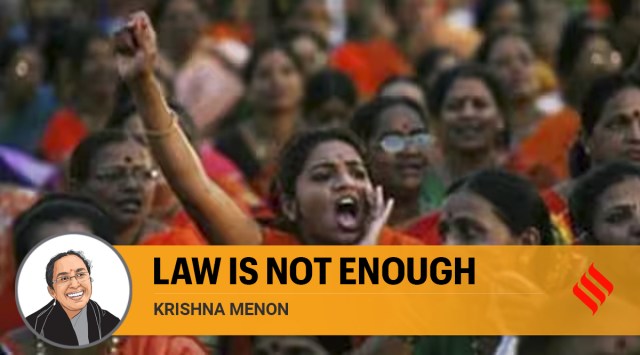
The Constitution (One Hundred and Twenty-Eighth Amendment) Bill, 2023, was passed by the Lok Sabha earlier this month with an overwhelming majority and received the President’s assent on Friday. It seeks to reserve one-third of the total number of seats in the Lok Sabha and state legislative assemblies, and the Legislative Assembly of the National Capital Territory of Delhi for women. The Women’s Reservation Bill, as it has been referred to, is now recast as the Nari Shakti Vandan Adhiniyam.
There have been some misgivings regarding the timing (just before the next elections), new name (women want equal rights and do not wish to be worshipped), manner of introduction (without any prior discussion with other political parties), absence of caste-based quota and intent (given that it has been linked to the variables of the Census and delimitation of Lok Sabha constituencies) of this Bill. In 2001, the Vajpayee government amended Article 82 (84th amendment to the Constitution), thereby barring any delimitation of constituencies before the 2026 census. This implies that the provisions of the Bill under discussion can be implemented only after delimitation (of Lok Sabha constituencies based on population) based on a Census that takes place post-2026. Multiple variables and the absence of a clear timeline have led to scepticism about the intentions behind its passage.
It has been a long struggle for women in India for the right to equal participation in politics. While there has been near unanimity among women as far as the goal of equal representation in legislative bodies is concerned, there are several differences on the approaches and methods (especially on the issue of reservation for women) for the achievement of these goals. Stalwarts such as Sarojini Naidu, Muthulakshmi Reddy and others in the pre-Independence period had diverging and complex views on the issue of reservation for women in legislative bodies.
The Constituent Assembly debates feature some leading women who resisted the idea of reservation for women in any form. Rajkumari Amrit Kaur, for instance, was of the opinion that such measures would weaken women’s self-esteem and confidence while also threatening the goal of national unity.
By the 1970s, the dismal figures on women’s work, health, education, political participation and other parameters were beginning to get noticed, thanks in large part to the landmark ‘Towards Equality Report’ (1974) of the Committee on the Status of Women in India. Interestingly, despite noting the dismal presence of women in legislative bodies, the Committee remained steadfast in its opposition to reservation for women.
The revitalised women’s movement of the 1980s and the changed political landscape of India in the 1990s, especially north India, characterised by some as the “Mandal vs Kamandal” phase (caste-based mobilisation vs Hindu mobilisation) created fresh thinking on a quota for women. While there was a general agreement amongst women political activists within political parties and civil society organisations about the need for measures (not everyone agreed with the idea of reservation in Parliament) to increase women’s political participation, there were sharp disagreements about the place of caste-based quotas within the Women’s Reservation Bill that was presented in Parliament in 1996. The struggles of women belonging to Dalit, Adivasi and other marginalised groups made it obvious that women experience exclusion due to a variety of discriminatory structures such as caste, religion, class, age and ability. The inability to reach an agreement on the issue of caste-based quotas within the proposed Women’s Reservation Bill in its earlier forms, saw the Bill languish in Parliament until now.
What have the men been thinking? Achyut Chetan in his new book Founding Mothers of the Indian Republic cites some male members of the Constituent Assembly who feared that the new-found freedom and equality would make women rivals of men thereby threatening Indian civilisational values. Similar fears were articulated by men belonging to leading political parties, including the current ruling party, with regard to the Women’s Reservation Bill in its several outings prior to 2023.
Given the history of an absence of unanimity over this issue in the past, the present consensus is intriguing. Do the many caveats and the absence of a caste quota make it seem less threatening to the established social order? In other words, has the Bill been defanged? It is not the provisions that are pertinent, as much as the context, when we look for answers to this question.
The passage of this Bill needs to be placed within the predominant political discourse that seeks to “respect, protect and venerate” (vandan) women, while remaining oblivious to the multiple ways in which women are excluded from work, subjected to violence (within their homes and in public) and targeted and trolled for being confident and having an opinion. Women are seen as passive recipients of largesse provided by the state, rather than as active and agential rights-bearing citizens. In such a milieu the Nari Shakti Vandan Adhiniyam (2023) is a largesse, rather than the right that women have been denied for so long. It needs to be placed in the context of a society that is grappling with the eclipsing of basic civility and increasing intolerance of differences.
The Bill seems to be, like a popular Malayalam proverb suggests, too bitter to swallow and yet too sweet to be spat out. Women understand that they need to be at the table when decisions are being taken, and the new law has the potential to ensure that. However, the strength of democratic forces outside Parliament and the state assemblies would determine whether or not these women are able to set the agenda and bring their issue to the table. Finally, the fond hope is that the women who get to Parliament and other legislative bodies will turn the tables when the opportunity arises.
The writer is Professor, Gender Studies, Ambedkar University Delhi